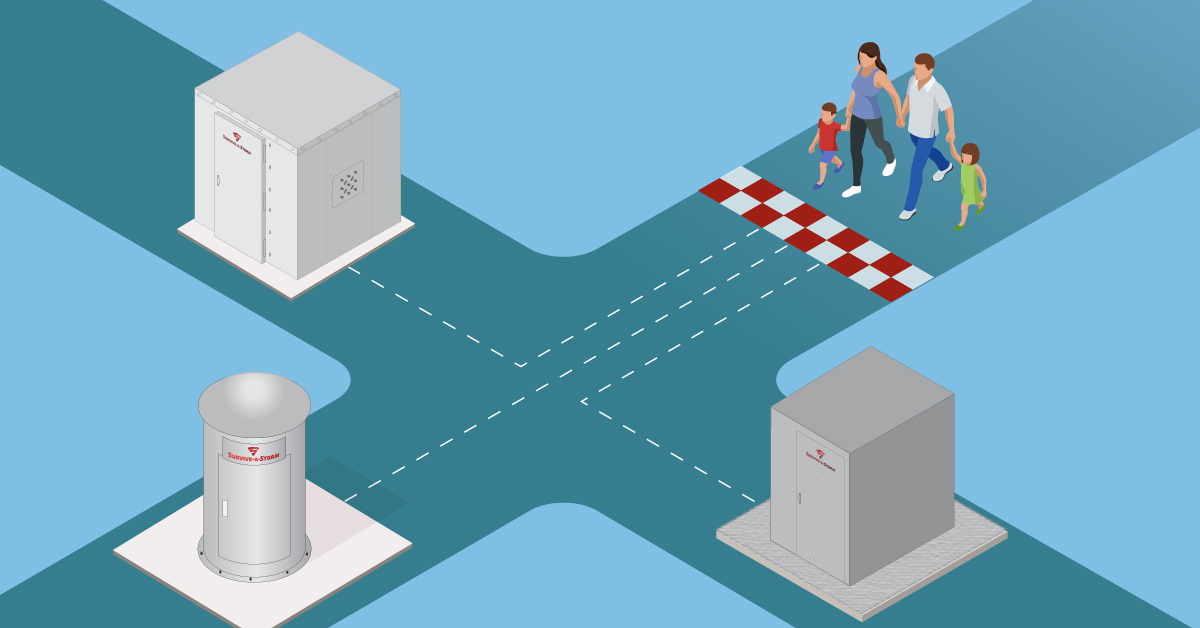CATEGORIES:
Safe and Sound: Exploring the Types of Residential Tornado Shelters
February 12, 2024

As the sun sets on a quiet suburban neighborhood, families gather in their homes in relative comfort and security. Inside, children play in the living room, parents prepare the evening meal, and the world outside is a distant concern. It's a testament to the peace that a safe home can offer. But, there’s also an unspoken understanding about the power of nature and the unpredictability of tornadoes. Safe and secure can change quickly without the right kind of protection from the fiercest storms.
Conversations about weather safety are as common as discussions about local sports teams or neighborhood events. When it comes to tornadoes though, the question isn't about whether to have a tornado shelter at all, but rather what kind is best suited for your family's unique needs.
Understanding Tornado Shelters
At its most basic, a tornado shelter is designed to protect individuals from extreme weather conditions, particularly tornadoes and other severe storms. These shelters should be able to withstand high winds and flying debris, the two primary dangers posed by tornadoes. Tornado shelters should be constructed using reinforced steel or concrete and anchored securely to resist overturning or uplift. (Or alternatively, they should be underground.)
People began taking precautionary measures and planning for tornadoes in the early early 20th century with rudimentary structures, or seeking shelter in root cellars and basements. The use of these shelters became more widespread in the area of the country known as Tornado Alley, after a series of devastating tornadoes in the mid-1900s defined the need for safer and more reliable structures. Over the years, advancements in meteorology and construction technology have led to the development of more sophisticated and effective shelters. Today's residential tornado shelters are the result of years of research and innovation, designed to offer maximum protection with materials and construction methods that meet stringent safety standards. The best shelters meet the standards established by the National Storm Shelter Association, or NSSA, which follow the standards of FEMA 320 and ICC-500.
The two main types of residential tornado shelters are underground and above-ground. This post will explore a few types of residential tornado shelter offerings. All Survive-A-Storm Shelters are designed for durability and safety, ensuring robust protection during severe weather events.
Underground Tornado Shelters
Many people consider an underground tornado shelter to be the gold standard when it comes to safety, since being underground they are already afforded inherent safety. And, they definitely ARE safe. They are typically constructed with durable materials like steel, ensuring high durability against extreme weather conditions. An underground shelter must also be corrosion-resistant and leakproof. If you meet the conditions necessary for an underground shelter, it is a great option.
However, the myth that “the only safe place to be during a tornado is underground” is just that - a tornado myth. For many people, an underground tornado shelter is just not feasible. It could be because the water table is high in their area or the area is prone to flooding. For others, there is an issue with accessibility. A few other things to consider include cost, with underground shelters typically being more expensive. An underground shelter will also require considerable excavation for placement, which will also add to the cost.
It’s important to factor in your needs and circumstances when deciding between above-ground or underground.
If an underground shelter is what you are seeking, Survive-A-Storm offers two models:
- GarageCube can be installed directly in a garage or an outbuilding with a concrete slab floor. This type of shelter is integrated into the existing structure of a home, making it a convenient and space-efficient option. It provides occupancy for 10 people.
- The Estate model is designed for installation in a yard, field, or separate building from the main residential structure. It provides flexibility in terms of location and is typically larger, accommodating 10-16 occupants.
Basement modifications are another option for those who have existing basements. Not all basements are tornado-safe, so some homeowners may choose to reinforce an existing room or place a manufactured tornado shelter in their basement. If you have an existing basement, the experts at Survive-A-Storm can guide you in what options are available for your home.
Above-Ground Tornado Shelters
Above-ground tornado shelters offer a compelling alternative to their underground counterparts, providing safety and convenience. They are also constructed from robust materials like reinforced steel, and they are engineered to withstand extreme winds and debris impacts associated with tornadoes. They are anchored to a concrete slab using guidelines from the NSSA.
One of the primary advantages of above-ground tornado shelters is accessibility. For families with elderly members or individuals with disabilities, there is easy access without the need to navigate stairs. This feature is crucial for ensuring quick and safe entry during an emergency. Additionally, above-ground shelters can be installed within the home, such as in a garage, basement, or even as a standalone structure on the property. This flexibility allows homeowners to choose a location that best suits their needs and space constraints. They are typically at a lower cost point and installation is usually faster.
Some of the challenges in an above-ground shelter is the space that the shelter will use, since it needs to occupy existing living space. And, of course, an above-ground shelter will be more visible, which might be a consideration for homeowners who are overly concerned about the aesthetics of their property.
If an underground shelter is what you are seeking, Survive-A-Storm offers a few models:
- The TwisterPod is a compact option accommodating up to four people. The TwisterPod Max accommodates up to six people. These make efficient use of space, are an attractive addition to any garage or carport, outside patio, and are ideal for small families or individuals.
- The Extreme model offers a larger space, suitable for bigger groups or families. There are six sizes available, accommodating between five and 16 people.
- The Panelized model is great for those needing a customizable solution. It provides flexibility in size and shape, being adaptable to different space requirements. It is intended to be used in the interior of a building.
Another concern that is sometimes brought up is debris and the possibility of the shelter door being blocked after the storm has passed. This concern is brought up with both underground and above-ground shelters. Survive-A-Storm offers a few solutions to this particular concern.
- All of our above-ground shelters have a secondary escape hatch that can be removed from the inside.
- A door jack can be added to any shelter and can be used to push the door open by force if there is something weighty blocking it.
- Survive-A-Storm shelters come with a unique alert system called StormWarn. This 3-part GPS alert system first alerts you when it’s time to seek shelter at your specific location, then delivers an all-clear message after the storm. If tornados touch down in your specific area, a live call (after the tornado) is placed to see if you need assistance. If no response is received, three pre-determined contacts are called. If we can't reach you or your contacts, local authorities are sent to find out if assistance is needed.
Making the Right Choice
Deciding between underground and above-ground tornado shelters involves considering several key factors. The first step is to assess your property's suitability for each type. Factors like the local water table level, soil type, and the presence of rock formations can influence whether an underground shelter is feasible. For instance, high water tables or rocky terrain can complicate or even preclude the installation of underground shelters. Conversely, properties with limited yard space or in urban areas might be better suited for above-ground options.
Accessibility is another crucial consideration. Above-ground shelters are generally more accessible, especially for individuals with mobility issues, as they don't require navigating stairs. They can also be installed within or attached to the home, offering quick and easy access during an emergency.
Budget and space constraints play a significant role too. Above-ground shelters can be more cost-effective and easier to install in certain cases, but they may require more space on your property. In contrast, underground shelters, while potentially more costly and involved in terms of installation, are often less obtrusive in the landscape.
It's also important to consider personal preferences regarding safety and peace of mind. Some individuals may feel more secure in an underground shelter, while others might prefer the convenience and accessibility of an above-ground structure.
Given these varied factors, it's advisable to consult with a professional who can provide personalized advice based on your specific circumstances. Professionals in storm shelter installation can offer valuable insights into the best type of shelter for your property, taking into account local building codes, weather patterns, and your family's needs. This expert guidance can help ensure that you choose the most suitable and effective tornado shelter for your home.
Preparing for a Tornado
Emergency planning and regular drills are crucial for families with tornado shelters, as they ensure that everyone, (including children, is familiar with what to do when a tornado warning is issued. These drills help in reducing panic, ensuring quick and safe access to the shelter. Staying informed about potential tornado threats is also vital. Families can use resources such as local weather alerts, mobile weather applications, and the National Weather Service for real-time updates. By combining preparedness with up-to-date information, you can fortify the security and peace of your home, including the unpredictability of tornadoes.
To get more information about Survive-A-Storm shelters, contact us today!




